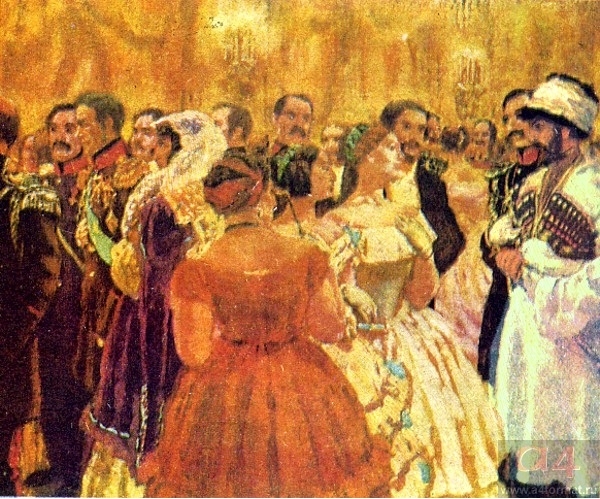Introduction and Background
Hadji Murat was one of the last works of literature that the aging Leo Tolstoy wrote, but you wouldn’t get that impression reading it. Absent is that preaching tone that marks much of Tolstoy’s work from around the time he finished Anna Karenina until his death. Instead we have a tale that is almost Classical in its grandeur, stakes, and larger-than-life characters. It takes place in the Caucasus in the years 1851-1852, at a point where the Russian subjugation of the native peoples – Chechens, Avars, and many others – was in full swing. The natives, under the Imam Shamil, are waging a brutal guerrilla war against Tsar Nicholas I’s Russian forces. Chief among the guerrilla leaders was one Hadji Murat, but when the story begins, he has decided to switch sides and join his hated Russian enemies. Shamil no longer trusts him and has imprisoned his family. He had little choice.

Against the backdrop of war, it is the personal that stands out. Hadji Murat, like War and Peace before it, shows the messy truth that lies behind maps and military manoeuvres. It shows the suffering, the heroism, and the dignity of ordinary people. Harold Bloom once called it “the best story in the world”. I’m not sure I would go that far, but it’s certainly among the best I’ve ever read.
Translations from the Russian are my own.
Characters over Plot – the Structure of Hadji Murat
One of the first things you notice reading Hadji Murat is that for a story with its hero in its title, the man himself isn’t the only prominent person here. Instead, Tolstoy makes sure to give us so many names and faces, and indeed places, that we’d be forgiven for thinking we’re reading something as long as War and Peace or Anna Karenina. Hadji Murat is a short book, but one of its unique strengths is that it acts like a long one. Even though most of the characters are only involved for a few pages, they are treated as though they could be there for longer. Whether this is a local officer, a cook, or somebody’s wife, we never know what role they’ll have to play.
And this makes us pay attention. Tolstoy’s strategy, it seems to me, has two important effects. The uncertainty surrounding the later involvement of characters means we have to consider carefully all of them in turn, instead of skipping hastily over those who other writers might mark (unintentionally) as having no further role to play. It all reflects an attitude that sees human dignity as more important than anything else, even concision and consistency. And that’s nothing to complain about, both because Tolstoy’s characters are drawn so well, and because the message of respect and human dignity is so important, especially in our times, when the statistical value of people seems more important than the idea that behind every number is a living, breathing person with their own hopes and dreams.
Violence and Death
The second important effect, very much related to the first, is that Tolstoy’s care for characters makes the underlying anti-war message in Hadji-Murat all the more powerful. In stories the main characters sometimes die, usually at the end, and any decent author can make such a death have weight for their readers. But Tolstoy’s careful portrayal of his minor characters means that even their deaths leave a mark.
One death that particularly affected me was the death of a simple soldier, Avdeev. He is introduced as one soldier among a small group, heading out for a quick smoke beyond the walls of their outpost. He doesn’t take a major part in their conversation, and we would likely forget him without a second thought. Tolstoy does not let us. When the soldiers fight a battle with the natives later on, one of them is wounded. “It was none other than that Avdeev who had been out smoking earlier”.
The wounded man is suddenly given a history not because Tolstoy has delved into his dying thoughts, but because he has connected a dying man with the life he had innocently led earlier, a life we ourselves had scarcely noticed. Avdeev’s life is banal, but it is life all the same, and that life has been robbed from him, and Tolstoy, rightly, wants us to be outraged. In dying he has achieved nothing. No grandeur nor glory surrounds him. He hadn’t even managed to load his rifle before he was hit. And as his comrades gather round him, the overwhelming impression is one of the pointlessness of his end, of the stupidity of it. “What, mate, does it feel bad?” One of them asks him. And then Avdeev dies.
But still Tolstoy does not leave him alone. The eighth chapter of Hadji Murat takes us to his home, where his family are hard at work. Avdeev, the virtuous youth, had volunteered to be conscripted in place of his brother, who had children of his own to look after, while Avdeev had only his wife. The family go around doing their simple tasks like threshing oats and bantering, and it’s painful to watch. They do not know that Avdeev is dead. The brother he has left behind is no good at the work and the family scold him for it. And though they all try to forget about Avdeev, to save themselves the worry, they think of him all the time – he was a good worker and they want to send him a letter and money.
The whole chapter is pointless. A modern editor, probably, would cut it. It does not advance the plot an inch. But its pointlessness is its very strength. The stupidity of the chapter within Hadji Murat reflects the stupidity of war and death itself, suddenly removing human joy and life. When at the end of the chapter the family finally hears that Avdeev has died, “protecting the Tsar, the motherland, and the Orthodox faith”, we feel disgusted. It’s a lie that provides no consolation for these lives. And it’s easy to understand, at this point, why his mother wails.

Authority
The message to Avdeev’s family connects the theme of pointless war-time death with its – in Tolstoy’s view – main cause: misguided authority. People are moved around, killed, and suffer, all because of people who are not affected by their decisions. And so they fail to appreciate them. If they did, Tolstoy would no doubt say, then there would be no more war. Hadji Murat, having lost Shamil’s trust and joined the Russians, finds himself trapped between two tyrants. Both Shamil and Nicholas I receive a chapter’s inspection by Tolstoy’s pen, and neither comes out particularly well. Shamil knows he is fighting a losing battle but refuses to surrender or find a compromise that would result in reduced bloodshed. Instead, he allows his men to believe they are winning against the Russians after all. But Shamil’s treatment is nothing next to Nicholas’s.
Hadji Murat is not a funny book, but the chapter detailing a moment in the life of Nicholas I’s is simultaneously tragic and hilarious. We find him receiving a report on the “capture” of Hadji Murat by the Russians. Tolstoy emphasises the contingency of Hadji Murat’s fate here. If Nicholas hadn’t been in a “bad mood” when he received the report, perhaps history might have been completely different. Nicholas, however, was. He is a petty womaniser, chasing after a married woman at a party, refusing to acknowledge any moral authority except his own, looking at the world through “lifeless eyes” (Tolstoy repeats the description three or four times in just as many pages). He is cruel and stupid. When worried, he begins “to think about what always calmed him: how great he was.” If he had no power, he would be funny, but he does, and the implications are terrifying.
Culture and Blood
Avdeev’s death is not the only one that is sprung on us. The first chapter of Hadji Murat details its eponymous hero’s arrival into a mountain village, where he is offered shelter by a friend. Once again, we are introduced to characters who we would otherwise forget. But Tolstoy, as the book draws towards its closing chapters, returns our attention to them. The Russians, chasing Shamil’s army, torch the village to the ground, kill the animals, and destroy the land. We see them come back from their shelter in the mountains to find their world in ruins.
“Nobody spoke about hatred towards the Russians. What they all felt, from the youngest to the oldest, was stronger than hatred. It was not hatred, but an unwillingness even to acknowledge these Russian dogs as people.”
Tolstoy fought in Chechnya as a young man. We have several short stories and the novel The Cossacks to show for it. But in Hadji Murat his attention goes beyond the Russians to their enemies. I cannot say if Tolstoy accurately portrays the Chechens, but I can say without a doubt that he portrays them with respect. By contrast, he has little love for the Russian army, with the pettiness of its commanders and brutality among much of its rank and file. Their tactics, of destroying the native forests and burning all they can, puts Hadji Murat next to Heart of Darkness as being a powerful Western critique of our own imperialism. Unfortunately, even now, I find most Russians expressing opinions about their southernly neighbours (now successfully “pacified” and “integrated”) that show they still haven’t learned the lessons Tolstoy was trying to teach them a hundred years ago.
We may have our differences, but we aren’t so different.
An Epic Figure – who was Hadji Murat?
No review of Hadji Murat could be complete without the man himself. But like Nostromo in Conrad’s novel of the same name, the figure of Hadji Murat is hard to pin down. While in Conrad’s work we rarely get a glimpse within Nostromo’s mind, Tolstoy freely tells us what Hadji Murat is thinking. But all the same, there is a tension in the story between rumour and official reports, and what Hadji Murat is actually like as a person. Legendary warlord Hadji Murat, we discover early on, is a human being. His main motivation in life is not some epic hatred of the Russians but simply protecting his own family – a universal concern.
The Russians he meets cannot believe that. They are always trying to work out how he’s planning to betray them. The Russians have a kind of mythic view of Hadji Murat that scarcely corresponds to reality. He’s never been scared, so one rumour goes. But when, in Tbilisi (then Tiflis), he recounts his life’s story to a Russian scribe, we find he has been scared like any other person, if only once. He has one leg short than the other – he’s no monstrous figure. But the Russians almost don’t want to see him like that. When they meet him they aren’t concerned with his personality. At public events in Tbilisi they only ask him one and the same question – “how do you find it here?”. It’s as if they only want to go home and say they’ve met the legendary warlord, rather than actually get to know him.

And what is he really like? A heroic figure, yes, but not only. He scarcely fights during the book. Instead, he’s full of life, with a “child-like” smile – exactly the sort of person who shouldn’t need to die. When he is given a Breguet pocket watch with a minute repeater function he spends hours listening to its chimes. He is also devout, constantly making time to pray and perform his ablutions. In short, he is a good man. If he is once described as like a caged beast, it is not because he’s an animal in Tolstoy’s eyes but rather because he is a victim of the Russian bureaucratic machine, which gradually dehumanises everyone. For Tolstoy the answer to the question “who is to blame” is obvious: the leaders, surrounded by sycophants and insulated from the pain their actions cause. Alas, not much has changed.
Conclusion
I had read Hadji Murat once before now, but then I barely understood a thing. My Russian wasn’t good enough, and I wasn’t willing to read slowly enough to compensate for it. This time I was better prepared. Tolstoy’s story demands slow and careful reading, though it is short, because otherwise we run the risk of denying the characters their own dignity. And there are so many exciting people here that I was spoiled for choice when it came to writing this review. Alongside Avdeev and Nicholas I, another one I was particularly struck by was the character of Butler, a young man who loses everything (and then some) at cards after striking up a friendship with Hadji Murat. Even though his role in the overall book is not great, his short story is so perfectly written that I would gladly have read an entire book that carried on his tale.
That, perhaps, is Tolstoy’s ultimate gift. He not only creates characters who are so real that the best of them live inside us, but he also creates characters who are so interesting that they make us realise that everyone around us has their own personal dignity, and everyone deserves attention and respect. Whether man or woman, Chechen or Russian, everyone has their own story, and the world would be better if only we stopped to listen.
For more Tolstoy, I made a translation of a late and fragmentary short story of his here. If you want to know about the spiritual changes that came over Tolstoy after Anna Karenina was finished, and why they spoil his writing, check out this essay of mine.


